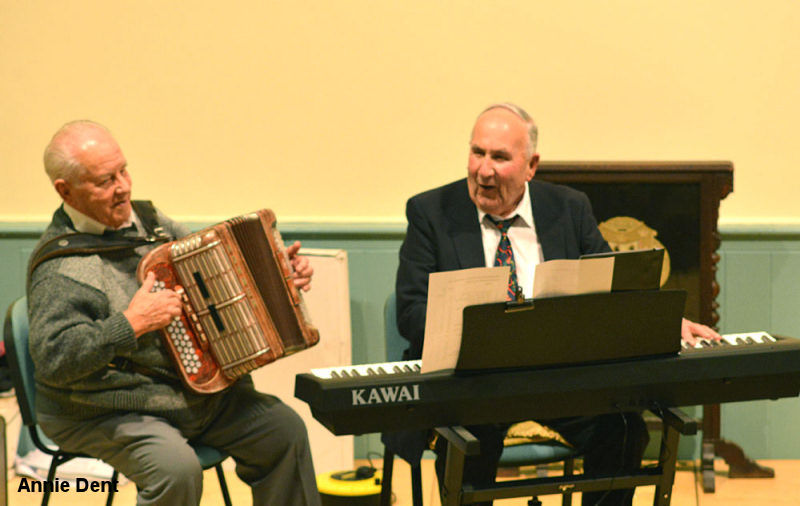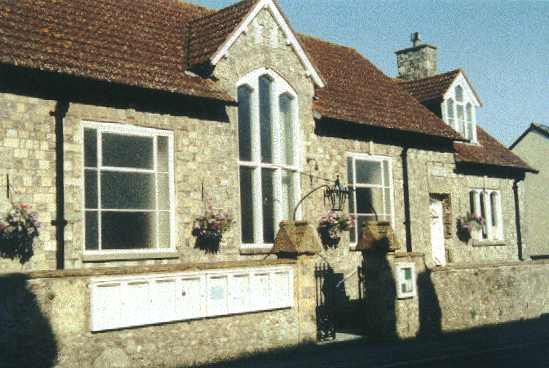|
|
| Everyone in Winsham is familiar with the Jubilee Hall. At the centre of the village, it has been the setting for innumerable meetings and performances. There are few who have not attended a village pantomime, play or concert,
and a wide range of age groups from Brownies to Over Sixties have pursued their activities here in the Jubilee Hall.
Many have sung or danced, painted or exercised, celebrated a family occasion or at public meetings, argued and
discussed.
It was used as a centre for the war efforts in two World Wars-for recruitment, an 'overflow school for evacuees' and lots of other purposes. It is a Polling Centre for national and local elections. There is very little that happens in the village community in which the Jubilee Hall does not play some part. If you look across Church Street at the Hall you can clearly see the dates 1837 and 1887, which commemorates the building of the Hall in the year of Queen Victoria's Golden Jubilee. Inside the dates are repeated either side of the main window in red and gold. Lord Bridport of Cricket St Thomas built the Hall for the benefit of the village, both as a meeting place and for educational purposes: it was referred to as a Reading Room. The role of the Parish Council The Winsham Parish Council, from the date of its first meeting, on the 13th  December
1894 has held its regular meetings in the hall, and on December 13, 2014 , the parish celebrated the 120th Anniversary of this
meeting, to the day, with a dinner, a play based on the history of the
Parish Council, written and produced by Stella Abbey, followed by
community singing led by Tony Meech. A record of this event can be seen by
clicking
HERE. The Parish Council also maintains a small office in the
building. December
1894 has held its regular meetings in the hall, and on December 13, 2014 , the parish celebrated the 120th Anniversary of this
meeting, to the day, with a dinner, a play based on the history of the
Parish Council, written and produced by Stella Abbey, followed by
community singing led by Tony Meech. A record of this event can be seen by
clicking
HERE. The Parish Council also maintains a small office in the
building.If you visit the gallery of this web museum devoted to the history of the Parish Council many references will be found to problems of management and up-keep of the hall. The cost of maintaining the fabric and facilities were always burdensome to the Parish Council, and it w  as the need to raise some £6,000 to install a
heating system that made it necessary, under the terms of a grant
from the Glubenkian Foundation, for the Parish Council to apply
for charitable status for the hall. In 1965 it became a Charity,
administered by a management committee, elected from village
organisations and by parish residents. A member of the Parish
Council continues to sit on the management committee as a
Representative member. as the need to raise some £6,000 to install a
heating system that made it necessary, under the terms of a grant
from the Glubenkian Foundation, for the Parish Council to apply
for charitable status for the hall. In 1965 it became a Charity,
administered by a management committee, elected from village
organisations and by parish residents. A member of the Parish
Council continues to sit on the management committee as a
Representative member.
An important social centre For many years, between the two world wars, within the memory of older people in the village, the highlight of the week was the "sixpenny hop" on Saturday nights. These were even more eagerly attended during the Second World War when American soldiers from the temporary camp at Cricket St.Thomas came along. Flirtations, on the part of the girls and fights, started by the anxious local lads, were a common occurrence. During this period, on weekdays the Jubilee Hall was also used as an 'overflow' school room, made necessary by the influx of children evacuated from the cities.
The need for on-going maintenance and
improvement To meet new safety regulations, plastic chairs,
curtains in fire resistant materials, Exit signs and circuit breakers were
introduced in the 1980s. In 1989 part of the chimney fell down in a hurricane (damaging the then playgroup leader's car) so the distinctive chimney was shortened.
2004-Jubilee Hall faces closure This was was successfully achieved as a result of a
wonderful community effort led by a very active Jubilee Hall Management
Committee. Grants were obtained from South Somerset District Council,
Defra, Awards for All, Wyvern Waste Management, and a number of other smaller grant
providers. The Parish Council gave £15,000,which was raised on the
precept. Local people were also very generous with time and money, and
this, with local fund raising efforts raised some £30,000. In about
eighteen months sufficient money had been raised to commence work. The
Hall closed at the end of June 2006 and reopened in January 2007.The
transformation was remarkable. The opportunity had been taken to totally
update the hall's facilities and appearance .
The years that followed : 2007-2019 In the years that followed the re-opening of the refurbished Jubilee Hall, work continued . The major project, was the replacement of the main windows at the front of the hall. There were many reasons for doing this. The main window was suffering from severe rot, and such a large area of glass was causing problems with heat loss during the winter months and over-heating of the main hall through solar gain in the summer months. The complex shape of the window meant that a bespoke solution was the only practical approach. The hall's location in a village designated as a conservation area also meant that planning approval was required. This work was carried out, with great skill and ingenuity by a local craftsman, Jamie Orr-Ewing. The work on the main window was completed in 2014, and the remaining windows , which involved the replacement of the old Critall metal framed windows, installed, it is believed in the 1950s, was carried out in 2016. In replacing the Critall windows, in addition to the practical reasons mentioned above, and improved ventilation, the replacement wooden-framed windows were made in the style of the original windows which were installed when the hall was built in 1887.As with the main window, planning approval was required before the work could begin. This was followed by a major task on the emergency exit door which was no longer fitting or operating properly. In 2019, work was done to overcome a major damp problem in the rear of the hall, adjacent to the men's toilets. The total cost of this work during the period from 2007-2019 came to just a little over £23,000, which also included the provision of a high quality digital keyboard, and a more modern digital projector for the main hall, with the associated complex wiring. The installation of the projector and the wiring was done on a voluntary basis by Keith Fowler, helped by his son, Jordan. During this period, another Winsham craftsman, Dan Anderson, a stone mason with great skill in letter carving, produced a new stone name tablet for the hall, along with access instructions for disabled visitors, also in stone. All the funding for the above came from a combination of local fund raising by the Jubilee Hall Management Committee, together with grants from 'Awards for All', a part of the National Lottery organisation. During this period the hall also suffered a series of set-backs, which included a major flooding incident due to the failure of a plumbing component, and a damp induced collapse of the plastering of a party wall. These all caused short term disruption in the hall's availability, with the cost of repair being met by insurance claims. A boundary wall also partially collapsed and was subsequently rebuilt.
On December 28th 2015, Phil Kershaw died. Phil had been the Hon. Treasurer of the Jubilee Hall since 1999, and had played a major role in the fund raising for the 2006 renovation and the subsequent financial management of the work. He continued to be actively involved in the financial affairs of the hall until his untimely death at age 80. He is greatly missed. For more information, including Annual Parish Reports and Accounts since 2004, Minutes of Management Committee meetings, and much more, click on the link below. JSS -Sept 2019 Jubilee Hall on Winsham Parish Web site __________________________________________________________________________________ Click HERE to return to Site Map Click HERE to return to Browse Index
|
|
Copyright ©
Winsham Web Museum. All rights reserved. |